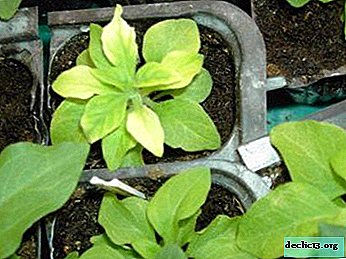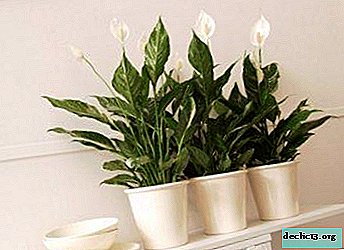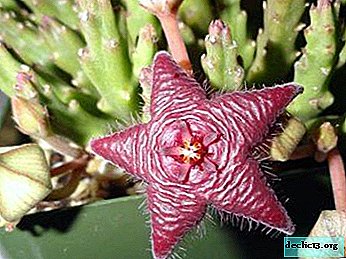Fragrant beauty rose Aqua: description and photo of flowers, as well as cultivation and use in landscape design
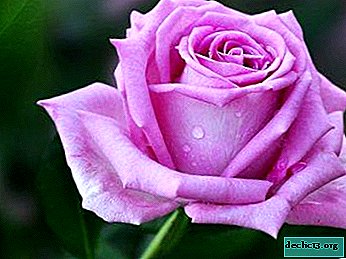
Roses Aqua due to their beauty, tall stalk, fast growth and pleasant persistent aroma, are very popular among gardeners.
It grows equally well both in greenhouses and greenhouses, and in open ground. The variety conquers with delicate buds of pastel colors and a pleasant, memorable aroma.
To enjoy such magnificence in your garden, you need to properly plant the plants and carefully care for the rose bushes.
Detailed description and difference from other species
Rosa Aqua belongs to the tea-hybrid varieties. This is a perennial plant.The bush reaches 0.8-1.2 m in height. The stems are green, erect, even and strong, practically do not have thorns. Buds with a diameter of 8-12 cm have a goblet shape. They are located singly on long sturdy peduncles or collected in inflorescences. Terry flowers are pink and lilac. Petals are dense, painted in light colors at the base, at the edges the color is more saturated. The hue of the flower changes depending on the stage of flowering and gradually fades under the sun.
Grade Benefits
 Suitable for cultivation in open ground, greenhouses and greenhouses.
Suitable for cultivation in open ground, greenhouses and greenhouses.- Blooms for a long time and continuously throughout the warm season, in the greenhouse - and in the cold months.
- Great for arranging bouquets.
- It tolerates short-term frosts.
- Has a bright floral smell.
- Resistant to many diseases and pests.
Disadvantages
- During the growing season, plants are highly susceptible to invasion of larvae and insects, there is a problem of the safety of buds.
- It does not tolerate severe frosts. At a stable temperature of -5 ° C, it needs winter shelter.
History of occurrence
Aqua rose bred by Dutch breeders by crossing repair and tea roses.
Photo
Further on the photo you can see how the Aqua rose looks:




Bloom
When and how?
Rosa Aqua blooms profusely and for a long time. Flowering begins in late June and lasts until the frost.
Features of care before and after
In the spring, after removing the shelter and pruning, roses are fed ammonium nitrate: 30 g per 1 sq. Km. m. After 2 weeks, the procedure is repeated. At the beginning of budding, a complex fertilizer with a nitrogen content is introduced. Before the first flowering, fertilizing with a mullein solution is carried out - 1:10. After the first flowering, the bushes are fed with full mineral fertilizer with trace elements.
To stimulate re-flowering, the bud after wilting is cut off above the upper quintuple. The remaining kidney should look out. Since mid-August, roses have not been pruned after flowering.Abundant flowering should not be allowed in the first year of plant life.. Small buds appearing in the first half of summer are cut off immediately.
What to do if it does not bloom?
If the rose refuses to produce buds, it is necessary to find out the reason and adjust the care. Flowering is prevented by factors such as:
- Nutrient deficiency.
- Excess nitrogen fertilizer. It is necessary to add ash or phosphorus-potassium fertilizer.
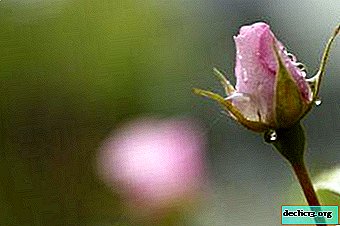 Lack of light.
Lack of light.- Errors during watering.
- Incorrect pruning.
- Rose is in venerable age. Dilute 1 tsp in 5 l of water. baking soda, ammonia and magnesium sulfate. Spray the bush 2 times with an interval of 10 days.
- The presence of wild growth. Dig the ground and cut off the wild shoot right from the root.
- Diseases and pests.
Use in landscape design
Roses Aqua are great for use in landscaping. They can be combined with other colors.
Advice:
- As companions, choose plants that love heat and light.
- Rose bushes look interesting in the company with vertical bell, sage and delphinium inflorescences.Proper planting vertically gives the garden a beautiful structure.
- Roses Aqua perfectly harmonize in color with plants of the cold gamut: Veronica, lavender, sage. The combination of pink and silver colors looks advantageous, for example: wormwood, cleaner, anaphalis.
- The original contrast creates a splash of small purple or blue colors.
- Rose bushes can be combined with cereals.
- The contrasting composition looks spectacular, in which roses are combined with perennial flowers and meadow herbs: aster, milkweed.
Step-by-step instructions for growing
Seat selection
The best place to land is a sunny areaon which at noon a light shadow falls. An important condition is good air circulation and the absence of strong gusts of wind.
 Ideally, if the rose garden is closed by a building or a dense hedge on the north side. Roses should not be placed closer than a meter from plants of equal height with them.
Ideally, if the rose garden is closed by a building or a dense hedge on the north side. Roses should not be placed closer than a meter from plants of equal height with them.
It is not recommended to choose a site:
- with a high occurrence of groundwater;
- in the shadow;
- in the sun;
- with large trees.
Lack of sunlight slows the development of roses and causes poor flowering. Excess negatively affects the color of the petals and reduces the flowering time.
What should be the soil?
Aqua prefers loose fertile soil, which allows air and water to pass through well. Optimum acidity - pH = 5.8 - 6.5.The soil should be moderately wet. It is not recommended to plant roses in heavy clay soil. If the site is loamy soil, you must add sand and rotted manure. The bush is planted in a hole with a previously prepared soil mixture having the following composition.
- Peat or humus - 1 part.
- Fertile soil layer - 2 parts.
- Gravel or sand - 2 parts. If the soil is sandy, this component can be omitted.
Seed planting
The method is unpredictable - the properties of the variety are not transmitted. Seed material can be bought or collected independently from own plants. Sowing seeds is better in April.
Seed preparation
- Place the seed in a gauze bag and lower it into a container with a 10% hydrogen peroxide solution. Purchased seeds do not need to be decontaminated.
- Moisten a cotton pad with hydrogen peroxide.
- Place seeds on top, cover with a second disk.
- Remove cotton pads with seeds in separate plastic bags.
- Attach a nameplate to the variety.
- Place in the refrigerator in the vegetable compartment.
- Check seeds regularly. In case of mold, repeat soaking in hydrogen peroxide, put on new cotton pads and put in the refrigerator. Seeds begin to germinate after 1.5-2 months.
Sowing
 Buy special soil for roses or form a mixture of fertile soil with perlite or vermiculite. Or use peat tablets. Before sowing, shed the soil with Fitosporin solution.
Buy special soil for roses or form a mixture of fertile soil with perlite or vermiculite. Or use peat tablets. Before sowing, shed the soil with Fitosporin solution.
- Take individual plates with a diameter of at least 5 cm with a drainage hole.
- Fill containers with soil to be moistened beforehand.
- Remove sprouted seeds from the refrigerator.
- Place seed on the surface without burrowing into the ground.
- Sprinkle lightly with perlite or vermiculite.
- Cover the container with foil.
- Send to a warm place.
- Moisten the soil with warm water as it dries. Remove condensate daily.
- When shoots appear, remove the shelter.
Seedling Care
- Lighting. Provide daylight hours of 10 hours.
- Temperature. Keep plants at temperatures from +18 to + 20 ° C. After the formation of several true leaves, the seedlings must be gradually adapted to lower temperature conditions.In good weather, take to the street - first a few minutes, then gradually increase the time.
- Top dressing. 2-3 weeks after emergence, apply liquid humic fertilizer. The dose indicated on the package should be reduced by 2 times.
- Disembarkation. At the end of May, when stable warm days come, young plants need to be planted in the garden. The first time to shade.
Temperature
Roses Aqua love warmth. Optimum summer temperature indicators are in the range from + 18 ° С to + 25 ° С. The maximum temperature is + 30 ° C, the minimum is -10 ° C. In winter, with a stable temperature within -5 ° C, the plant needs shelter.
Watering
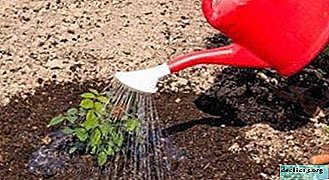 Depending on weather conditions, Aqua roses are abundantly watered 3-4 times a week. Use settled water having an ambient temperature. The best time for the procedure is evening or early morning.
Depending on weather conditions, Aqua roses are abundantly watered 3-4 times a week. Use settled water having an ambient temperature. The best time for the procedure is evening or early morning.
- Loosen the soil around the bush, make sides.
- Water directly under the root.
- Loosen the soil to a depth of five to eight centimeters.
- When water is absorbed into the soil, dust the ground around the bush with ash and pour a layer of mulch.
Overmoistening should be avoided.. When watering, moisture must not be allowed on the stems and leaves, otherwise fungal diseases can be provoked.
Top dressing
Top dressing is introduced from spring to early autumn. In the spring season, complex mineral fertilizers are used with a solution of ammonium nitrate: 50 g per 10 liters of water. In the summer, after cutting flower stalks, preference is given to complex formulations with the addition of organics and trace elements. In the fall, potash and phosphorus are used. The first top dressing is carried out immediately after sanitary pruning of roses and the appearance of buds. In spring, the procedure is carried out every two weeks, in the summer - 3 or 4 times.
Before top dressing, the soil must be moistened. The method of application depends on the type of product used. A solution of the drug is watered on the basal soil or granules or powder are mixed to the soil around the bush. After each feeding, the soil is mulched.Pruning
A sanitized tool is used for trimming - a well-sharpened knife or pruner. Event Dates:
- Spring pruning. It is carried out after removal of the shelter. The task is to remove damaged and dead stems. Cut the top of the shoots, leaving 15 cm in height and 3 buds on each branch.
- Summer. Includes timely removal of peduncles.
- Autumn. The purpose of the procedure is preparation for wintering.
Transfer
 It is recommended to plant bushes of this rose variety from September to October, before the onset of the first frost.
It is recommended to plant bushes of this rose variety from September to October, before the onset of the first frost.
- Keep the seedlings in water for 4-5 hours.
- Dig holes so large that the roots fit freely. The distance between the bushes is at least 80 cm, between the rows - up to 2 m.
- Put drainage in the hole, pour a mixture of fertile soil and humus. If planting is carried out in the spring, apply organic fertilizers to the ground.
- Dip the roots of a seedling in wood ash.
- Place the seedling in the center of the hole.
- Carefully spread the roots.
- Sprinkle with earth. Deepen the root neck no more than 5 cm.
- Abundantly water the seedlings.
- Mulch the soil around the trunks with a layer of at least 7 cm.
Preparation for winter
The rose of the Aqua variety is not very resistant to frost.Winter preparations begin at the end of summer:
- In late August, watering was gradually stopped and nitrogen-containing fertilizers ceased to be applied. Use potassium top dressing.
- In early or mid-September, the aerial part is cut off at a level corresponding to the height of the shelter. Spray the bush with a Bordeaux mixture or a solution of iron sulfate. They plant a plant to a height of 20-25 cm.
- In mid-October, when a stable negative temperature is established, shelter is made. A popular option is a metal or wooden frame up to 60 cm high. Insulation is placed on top - ordinary cardboard is suitable. The last layer is a plastic film.
Step-by-step instruction: how to propagate?
Roses Aqua is easiest to propagate by dividing bushes. The method is suitable for specimens grown by rooting by cuttings, layering or dividing the bush. The event is held in early spring.
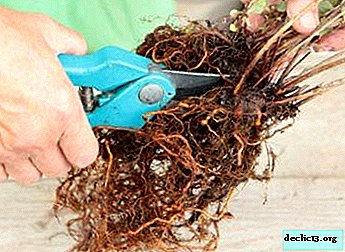 After the earth has completely thawed, but the buds have not yet appeared, dig up an adult bush. If the mother plant needs to be preserved, only the peripheral part can be separated with a shovel.
After the earth has completely thawed, but the buds have not yet appeared, dig up an adult bush. If the mother plant needs to be preserved, only the peripheral part can be separated with a shovel.- Disinfect pruning shears. Carefully divide the bush into parts, each of which should have roots and one shoot.
- Cut damaged roots to the healthy part.
- Shorten the shoots by 2/3, leaving 3-4 buds on each. The upper left kidneys should not be directed inward.
- Dip the roots into the clay mash.
- Plant bushes in the soil in the usual way with a depth of 5 cm.
- Water abundantly. To spud.
Diseases and Pests
Most often, representatives of the Aqua variety are affected by fungal diseases.Common Diseases:
- downy mildew;
- gray rot;
- rust.
Pests of aqua rose bushes:
- aphid;
- leaflet;
- spider mite;
- moths;
- nematodes.
At the beginning of the growing season and once a month in the summer, it is imperative to carry out preventive spraying against pests and fungal diseases.
Roses Aqua are distinguished by sophisticated beauty and pleasant aroma.. The variety is characterized by medium frost resistance and good resistance to diseases. Roses Aqua are widely used both for cutting and arranging bouquets, and for decorating the garden.
Interesting video
We offer you to watch a video review of a rose variety Aqua:

 Suitable for cultivation in open ground, greenhouses and greenhouses.
Suitable for cultivation in open ground, greenhouses and greenhouses. Lack of light.
Lack of light. After the earth has completely thawed, but the buds have not yet appeared, dig up an adult bush. If the mother plant needs to be preserved, only the peripheral part can be separated with a shovel.
After the earth has completely thawed, but the buds have not yet appeared, dig up an adult bush. If the mother plant needs to be preserved, only the peripheral part can be separated with a shovel.


